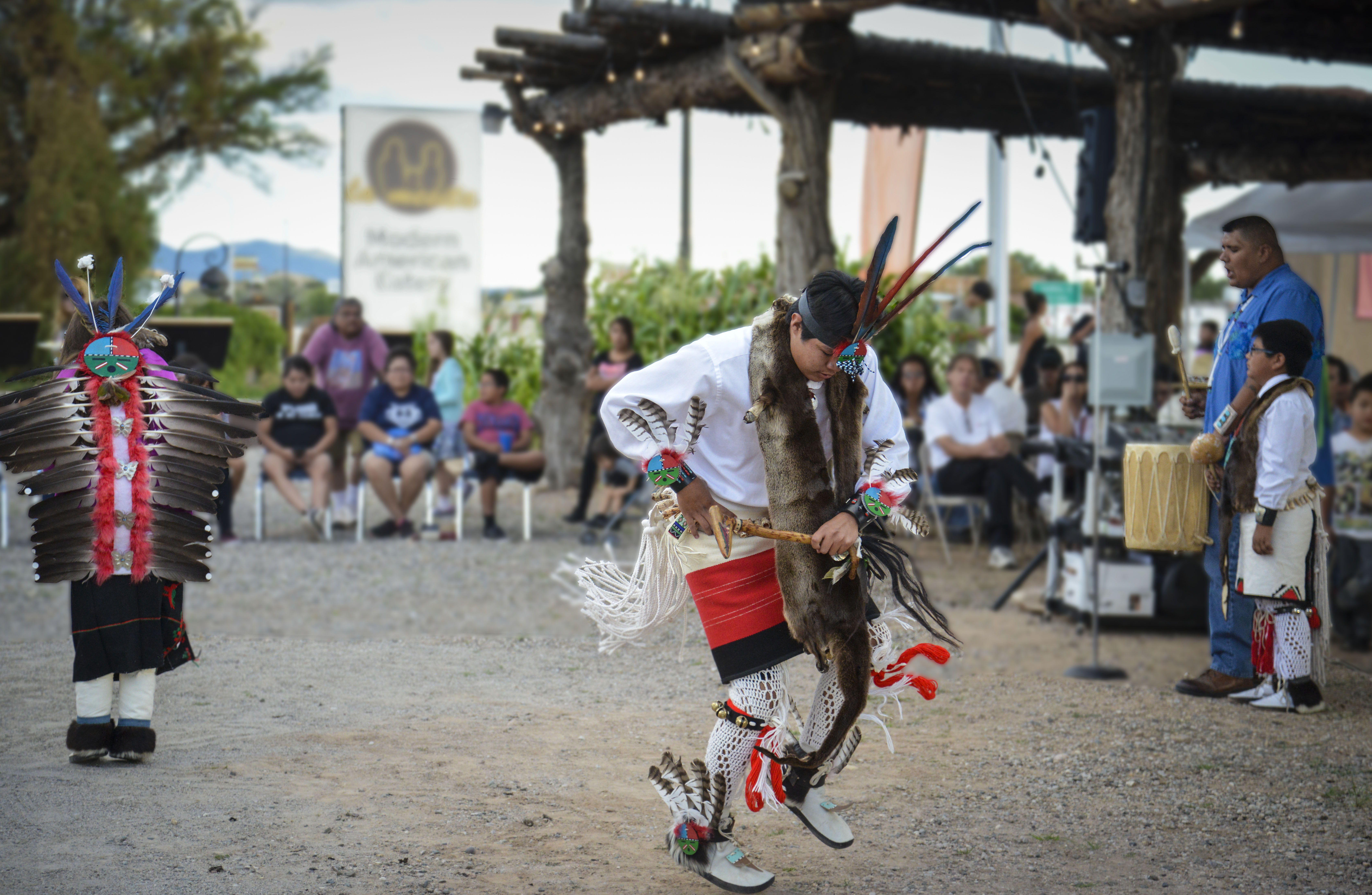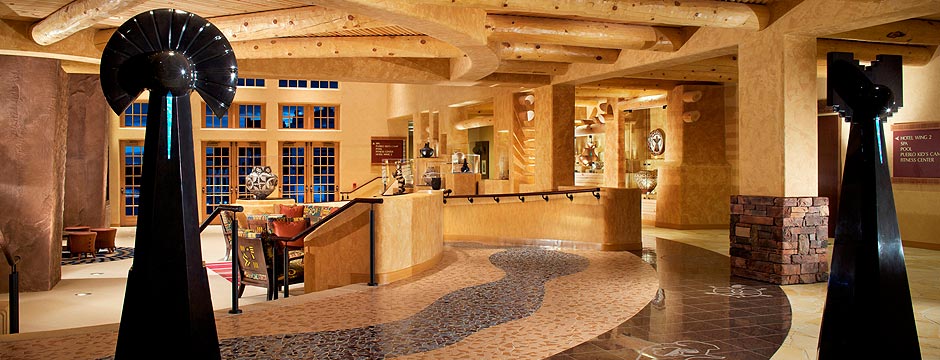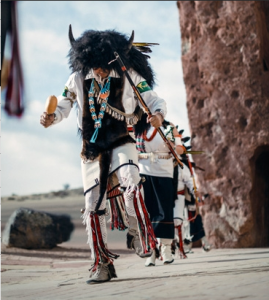Poeh Cultural Center & Museum

Imagine authentic Native American arts and the opportunity to interact directly with a Pueblo tour guide. The Poeh Center emphasizes cultural preservation and revitalization through the arts and cultures of all Pueblo People — with a focus on the Tewa-speaking Pueblos of Nambe, Pojoaque, San Ildefonso, San Juan, Santa Clara and Tesuque; and the Tiwa-speaking Pueblos of Picuris and Taos.
Since its inception, the Center’s mission has been to support the future of Pueblo people by: teaching the arts, collecting great works of art, and promoting public under-standing of, and respect for, Pueblo history and culture. After twenty-five years, the Center, its educational initiative, Poeh Arts, and its Museum have taken that mission to heart and evolved into successful vehicles for artistic expression, both Native American and public education, and successful economic development strategies.
Tewa is the traditional language and the culture of six of New Mexico’s eight northern Pueblos. In Tewa, “Poeh” means pathway. The Poeh Center is a living pathway where tradition travels between the past and the present and leads into the future, ensuring further creativity. In this role, the Poeh Center embodies the essence of what it means to be Tewa — to be Pueblo — in a context of cultural continuity.
www.poehcenter.org
505.455.5041
Buffalo Thunder Art Collection

An art museum in itself, Buffalo Thunder is home to hundreds of pieces of unique art, sculptures and architecture—every room offers hand-designed furnishings and work by local artists, including Pueblo of Pojoaque Governor George Rivera.
While you explore the resort, you will find works of art representing every Native Tribe within New Mexico. Several works have been created within traditional means, while others are created using traditional materials that make them seem quite contemporary. Equally, these styles of work are absolute compositions woven from Native American history.
We hope that you take the opportunity to explore our over 300 one of a kind pieces located throughout our gallery-like surroundings.
Also located on the Pueblo of Pojoaque is the Poeh Museum. A Native American Art and Culture center, the Poeh museum is operated by the Pueblo of Pojoaque. With a primary emphasis on art and artists from Northern New Mexico’s six Tewa speaking pueblos, the museum focuses on preserving traditional and contemporary Pueblo art and culture. They exhibit rapidly growing collections including contemporary, historical, and archaeological works-an invaluable resource to artists and researchers from both within and outside the Pueblo community.
The Poeh Museum currently curates two collections: a permanent collection, which holds Pueblo material and cultural objects; and a photo archive, which contains historic and contemporary images of Pueblo culture, artists, and the Pueblo of Pojoaque community.
Pueblo Feast Days
 “Feast Days” at each of the Pueblos are named after the Pueblos’ patron saint. The Pueblos open up their respective Feast Days to the public where visitors can view the revenant dances and songs offered on those days.
“Feast Days” at each of the Pueblos are named after the Pueblos’ patron saint. The Pueblos open up their respective Feast Days to the public where visitors can view the revenant dances and songs offered on those days.
Feast Days bring tribal members together to renew their culture, language and native religion. On those days, families prepare food for the many invited visitors coming through their homes, and participate in the activities taking place on their Feast Day. Pueblo Feast Day Dates do not change and are held on the same date each year. (from Pueblo Cultrual Center)
The Pueblo of Pojoaque Feast Day is held annually on December 12 at the Pueblo’s plaza. (near the Tribal Council Chambers & Early Childhood Center)
Etiquette
While the Pueblo people are traditionally generous and welcoming, there are etiquette guidelines that should be followed to avoid violations of their customs or misunderstandings. Here are suggestions for ensuring that your visit to a pueblo is enjoyable for everyone involved:
- Use the visitor center or tribal office as the first point of contact. (Remember that both are closed on feast days.)
- Observe all rules and regulations of the individual pueblos. Obey all signs and do not enter off-limit areas.
- Obey all traffic, parking and speed limit signs.
- Homes are private. Do not enter without an invitation.
- Do not climb walls or other structures as they may be hundreds of years old and easily damaged.
- Kivas and graveyards are not to be entered by non-Pueblo people.
- Please control children and make sure that they are respectful.
- Stay in the immediate village area, do not wander.
- Do not pick up, remove or disturb any artifact or objects such as pieces of broken pottery, plants, rocks or animals.
- Do not bring alcohol, weapons, drugs or pets into Pueblo communities.
There are also some rules for courteous behavior when attending ceremonial dances and feast days. The first is to realize that the dances are religious in nature and not staged performances. As such, they should be observed with respect and quiet attention. Talking or asking questions of dancers or non-dance participants should be avoided. Applause after dances is not appropriate. On feast days, when many families open their homes, it is courteous to accept an invitation to eat but not to linger or offer more than heartfelt thanks for the hospitality.
The pueblos have rules about taking pictures and making sketches and recordings while visiting their communities. It’s best to find out in advance about the permits, fees and restrictions at each pueblo you plan to visit and whether photography, sketching or recording is prohibited. Even after you’ve obtained a permit, you should always ask permission before taking an individual’s picture, make sure that your photography doesn’t interrupt or interfere with dances and remember that pictures are for private use only and may not be reproduced or sold without written permission.
from Santafe.org
